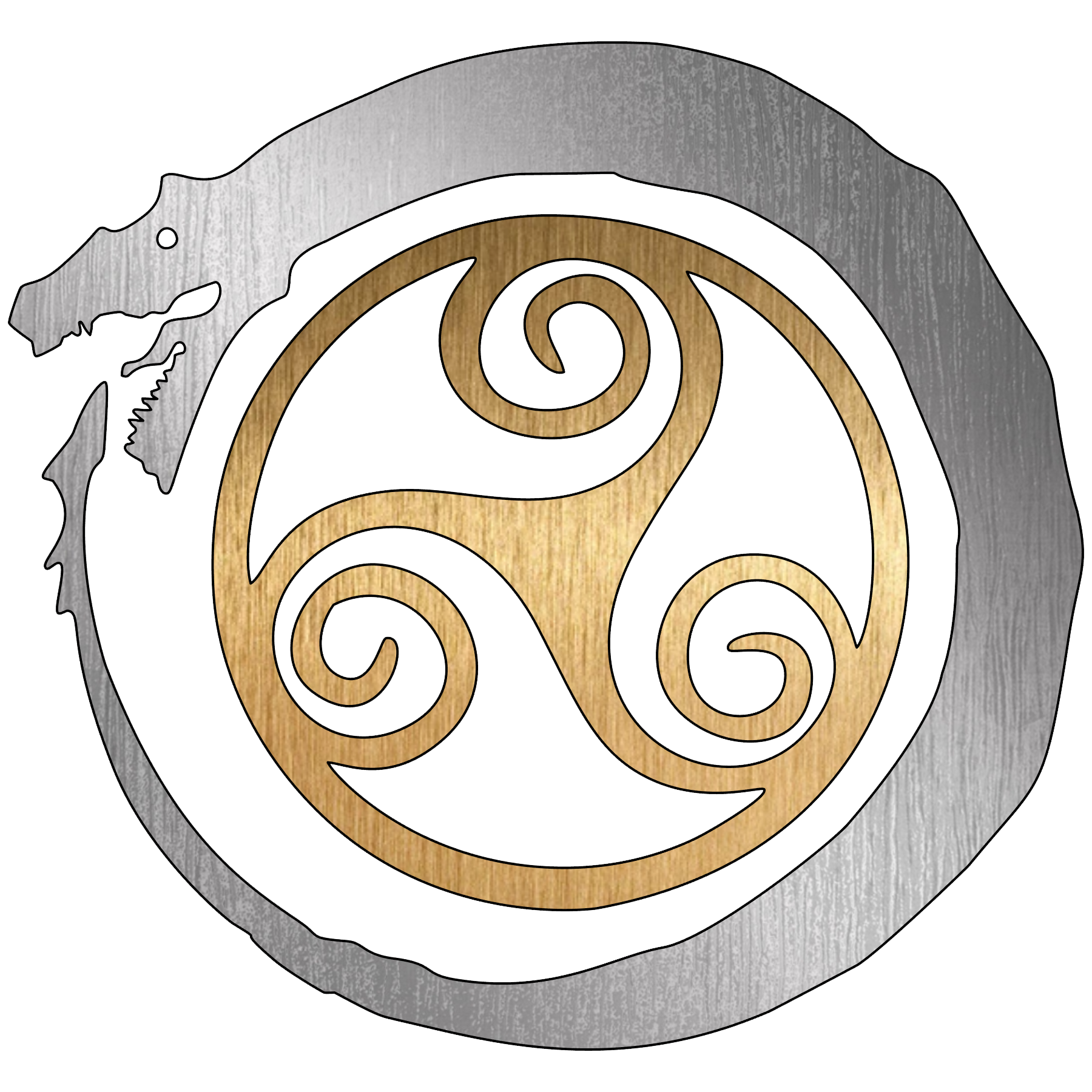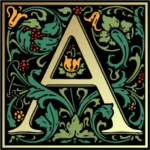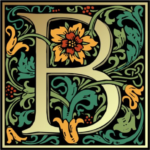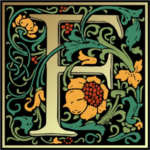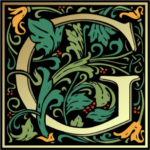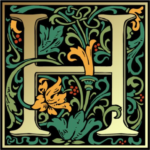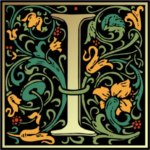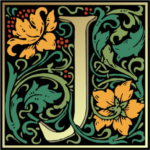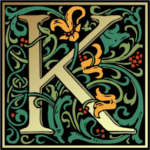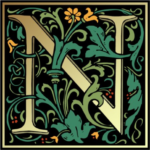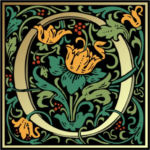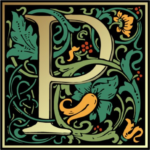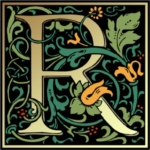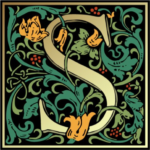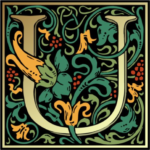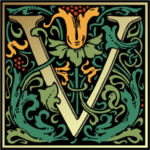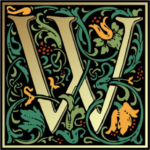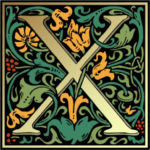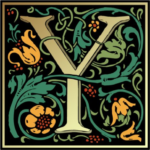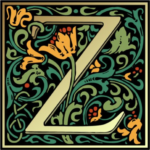Ásatrú Glossary
Ásatrú has long been known colloquially as the “Religion with Homework”. There is always more to learn! In learning, whether as a new walker on this path, or a seasoned veteran, we sometimes come across terms we are not familiar with. This list, while by no means an exhaustive one, is a compilation from various online sources of the common terms found in Ásatrú.
Table of Contents
Alfheim
Alfheim [ALF-heym] – Alfheim (Old Norse Álfheimr, “The Homeland of the Elves”) is, as the name suggests, the world inhabited by the elves, a class of demigod-like beings in the pre-Christian mythology and religion of the Norse and other Germanic peoples. Alfheim is never described in the sources that form the basis of our current knowledge of heathen Germanic religion, but is rather merely mentioned in passing in a few places. However, the elves are described as being luminous and “more beautiful than the sun,” so we may suppose that their homeland was a gracious realm of light and beauty. Although the realms that comprise the Nine Worlds of the Norse cosmology are never listed, it seems highly probable that, given the prominence of the elves in Germanic religion, Alfheim was one of them. The Vanir god Freyr is said to be the ruler of Alfheim. Scholars have long puzzled over what to make of this, and no wholly satisfactory conclusions have been put forth. The relationship between the elves and the Vanir is highly ambiguous and involves considerable overlap between the two groups. Freyr’s position as lord of Alfheim, therefore, while hard to interpret with much precision, shouldn’t be entirely surprising.
Allsherjargoði
Allsherjargoði [alsˌhɛrjarˌkɔðɪ]; plural -goðar] – The chief religious official of the Icelandic neopagan organization Ásatrúarfélagið in Iceland. High Priest, more commonly referred to as an elder. Historically, only someone in the Heathen community who had attained the greatest of respects could occupy this esteemed office of religious and public service.
Alþingi
Alþingi/Althing [ALL thing] — The national parliament or “general assembly” of Iceland. Founded in 930 CE, it is the oldest parliamentary system in the world. Some Modern Heathen groups have appropriated this term to refer to any large inter-regional, national, or international religious convention of Heathens.
Ancestor Veneration
Ancestor Veneration – A practice of importance to most Heathen religions and individual practitioners. Practitioners pray and offer to their deceased loved ones for various forms of intercession. It is based on the belief that the dead maintain a continued existence in a “next life,” and have the ability to give counsel to the living and influence the luck of their families. Ancestors are not necessarily blood-related. Biological ancestors are not the only dead a person may venerate. Adopted persons, and those who have been disowned or have otherwise renounced their biological families, tend to revere the ancestors of their adopted family.
Ásatrú
Ásatrú [ASS-uh-troo, OWSS-uh-troo] — A term comprised of the Old Norse words Ása, referring to the Norse gods, and trú, “troth” or “faith”. Thus, Ásatrú means “religion of the Æsir.” The term was coined by Edvard Grieg in his 1870 opera Olaf Tryggvason, in the context of 19th century romantic nationalism. It is a term that describes one of many revival Heathen religious movements. Ásatrú, the Modern attempt to revive the old Norse faith, was founded by the Icelandic farmer Sveinbjörn Beinteinsson (1924–1993). Beinteinsson was a sheep farmer and a priest in the religion, who published a book of rímur (Icelandic rhymed epic poetry) in 1945. In 1972, he petitioned the Icelandic government to recognize the Íslenska Ásatrúarfélagið,or Icelandic fellowship of Æsir faith, as a religious body. It did so in 1973, and Denmark and Norway have since followed.
Ásgarðr/Esageard/Ensigart/Asgard
Ásgarðr/Esageard/Ensigart/Asgard [OWSS-gahrthrr or AHSS-gahrthrr, with voiced “th,” EY-suh-yay-urd, ENN-si-gahrt, AS-gard] – home of the Æsir, one of the nine worlds–Norse, Anglo-Saxon, Armanic German. Often anglicized Asgard.
Barrow
Barrow [BAR row] — A traditional tumulus, or burial mound. Historically, barrows were the preferred method of Viking burial, despite popular Modern belief. From the barrow, interred ancestors were believed to remain to offer spiritual guidance to their descendents. Not all dead were benevolent, though, and some dead became haugbui, or malevolent undead living on in their tombs. For more information on Norse ghosts and undead, please consult The Viking Answer Lady.
Berserkr
Berserkr, plur. berserkir [BERR-serrrkrr, BERR-serr-keer or berr-SERR-keer, with each single “e” as in “get”] warrior who fought in a crazed state, insensible to pain–Norse, “bear-shirt” or “bare-shirt” (i.e.: shirtless), two possible etymologies. Anglicized berserk, berserker.
Bifröst
Bifröst [BIH-fröst, or anglicized BYE-frost] – Rainbow Bridge to Asgard; the rainbow.
Blót/bletsian
Blót [bloat]/bletsian [BLET-see-un] — Ritual slaughter of a livestock animal. Blót for all intents and purposes translates to “blood,” which in Heathen religions is one of the most sacred of fluids. A blót is usually performed outdoors, in nature, and is a formal, communal occasion. Food and drink may be offered at a blót, during a special feast called a husel, where the sacrificial animal is consumed by the participants. Some of the drink will be poured out onto the soil as a libation for the Gods, etc. A blót is often performed in honor of the Gods, or a prominent guest, or during very special occasions, such as a wedding. The blood from the sacrificial animal is collected in a bowl, called a hlautbolli. This blood is referred to as hlaut. Boughs, branches, short brooms, or brushes, referred to as hlautstaves, are dipped in this blood. Altars and temple walls, both outside and inside, are sprinkled over with the sacral blood using hlautstaves. Practitioners can also be anointed with this blood.
Dís
Dís, plur. dísir [deess, DEE-seer] / idise, plur. idesi [EE-di-say, EE-day-see] – female ancestor who serves as a guardian and advisor to members of a family.
Dísablót
Dísablót [DEE-sa-bloat] – ceremonial observance of the dísir and associated festival day.
Dökkálfar
Dökkálfar, svartálfar [DÖCK-owl-vahr or –ahhl-vahr, SVAHRRT-owl-vahr or –ahhl-vahr] – black or dark elves, usually identified with the dwarves–Norse.
Eostre
Eostre [EY-oss-trey] – Anglo-Saxon spring festival, originally in honor of goddess of the same name, which gave its name to Easter; non-Anglo-Saxon heathens use Ostara.
Ergi
Ergi [AIR-yee] – depravity; receptive homosexuality; an extremely insulting word with varying meanings in the lore, usually used in modern times in its late Icelandic, anti-homosexual meaning.
Etin
Etin [Ateen] – These wights are the children of Ymir, dwelling in the wild realm of the Out-Garth. In the religion of the North, they usually embody the forces antagonistic to human kind – the forces of raw nature, which Thunar and Fro Ing ward us against. They are the man-eating fiends that haunt wild places; they are outlaw wights, beings of unholiness. All of them are very closely connected to the realm of death; they are the eaters of the dead, against whom Thunar’s hammer hallows the funeral pyre and the memorial stone.
The etins (Old Norse jötnar, singular jötunn) are primeval beings of great wisdom, able to meet with the god/esses on equal terms – and to breed with them; Wodan’s mother was the etin-maid Bestla. They are wise wights, skilled in the crafts of magic. Some are helpful; the wisest of all the etins is Mímir, Bestla’s brother, keeper of Mímir’s well, to whose head Wodan goes for rede in times of trouble; the goddess Skadhi is herself an etin and the daughter of one of the Ases’ Garth’s great foes; and the prophetess who speaks to Wodan in the Eddic poem “Völuspá” speaks of having been fostered by etins in the earliest times. Most of the etins are terrifying beings; however, the word “etin” comes from a root meaning “to eat” – like all of Ymir’s children, they are devourers of light and life.
Faining
Faining [FEY-ning]— From Old English fægen, akin to Old Norse feginn, meaning “glad,” or “joyful.” To fain means to celebrate. It is an alternative term for blót. Faining can also refer to the act (sóa)of sinking, burning, or breaking votive offerings to the Gods or other spirits.
Folkish
Folkish – Any form or sect of strictly Conservative Heathenry that maintains the necessity of European (“White”) ancestry in order to worship European (“White”) Gods. Many Folkish groups are either overtly racist, or maintain constituencies that are largely comprised of racist individuals. In direct contrast to their actions and beliefs, they publicly deny allegations of racism, however. They claim that they are merely suggesting that all races return to their respective “cultural wells.” They believe people of African ancestry should practice African religions and not pursue Northern European religion, while those of European descent should worship European Gods, and so on. “Non-Whites” are usually not allowed to, or are treated poorly at, Folkish Heathen events.
Freyfaxi
Freyfaxi [FREY-facks-ee] – Harvest-time festival in honor of Freyr/Fréa celebrated by most Ásatrú.
Frith
Frith – Certainly one of the more complicated terms within Modern Heathenry. It holds varying meaning for historical Northern European cultures, but all portray a sense of “peace” and “sanctuary.” It is not about “being nice,” by shying away from controversy and having dissidents keep their heads down and mouths shut. Disagreements are not a violation of Frith. Rather, Frith is about maintaining equitable order within a community, and providing equal protection and equal voice to all who belong to that kindred/community in a lawful manner. In terms of Anglo-Saxon and post-Anglo-Saxon culture, the term has a considerably broader scope and meaning. Frith has a great deal to do not only with the state of peace, but also with the nature of social relationships, and the laws which protect and enforce the desired state of order. The word friþgeard, meaning “asylum, sanctuary,” was used for sacred areas — specifically any consecrated area given over to the worship of the Gods. The friþgild —literally, “peacekeepers” — was a group of men within an Anglo-Saxon community charged with the task of maintaining order and enforcing the law. They were the antecedents of the Medieval watch, and Modern policemen. Frith is historically used within the context of fealty and vassalage, as an expression of the “feudal” relationship between a lord and his people.
Fulltrúi
Fulltrúi [full-TROO-ee] – An Icelandic word meaning “attorney, dean, delegate, deputy, lawyer, lieutenant, representative.” In a Heathen context, it refers to devotee-to-deity relationships. Heathenism, generally speaking, does not entertain the notion of “Patron/Matron deities” in the sense that some other Modern Pagan and Polytheist religions do. Not all deity relationships go “both ways.” There is not always a guarantee that the God an individual pays closest attention to chose that individual in the first place. To say that a particular God is one’s fulltrúi is to explain that one is devoted to a particular God, but that particular God may not be responding to that devotee in a “Patronly/Matronly” fashion.
Fylgja
Fylgja/fæcce [FÜLG-yuh or FILL-gyuh, FA-chey with “a” as in “hat”] – personal tutelary and guiding spirit, usually in animal form, similar in many ways to a Native American totem animal. The word fylgja means “to accompany” similar to that of the Fetch in Irish folklore. It can also mean “afterbirth of a child” meaning that the afterbirth and the fylgja are connected. In some instances, the fylgja can take on the form of the animal that shows itself when a baby is born or as the creature that eats the afterbirth. In some literature and sagas, the fylgjur can take the form of mice, dogs, foxes, cats, birds of prey, or carrion eaters because these were animals that would typically eat such afterbirths.
Other ideas of fylgjur are that the animals reflect the character of the person they represent, akin to a totem animal. Men who were viewed as a leader would often have fylgja to show their true character. This means that if they had a “tame nature”, their fylgja would typically be an ox, goat, or boar. If they had an “untame nature” they would have fylgjur such as a fox, wolf, deer, bear, eagle, falcon, leopard, lion, or a serpent.
The animal fylgja is said to appear in front of its owner, often in dreams, and offer portents of events to come. As such it is a representation of the future itself, not the character of a person. Like a person’s fate the fylgja is not changeable, nor can it improve or act on its own.
Galdr
Galdr [GAWL dur] – An Old Norse term meaning “incantation.” The original Norse verb “gala” means “to crow.” It later came to mean magic in general. Runegaldr is a form of verbally-based magic (galdr) incorporating the articulation of the runes.
Ginnungagap
Ginnungagap [GINN-oon-gah-gap, YINN-oon-gah-gap] – the nothingness that existed in the beginning. The void in which the world was created. The story is told, with much variation, in three poems of the Elder Edda, and a synthesis of these is given by Snorri Sturluson in his Prose Edda.
Godspouse
Godspouse – Godspousery is a highly convoluted, controversial topic, particularly within Heathen religions. Strict Reconstructionist forms of Heathenry tend to reject its practice wholesale. Not quite the same as Catholic nuns who are “married to Christ,” or highest-of-the-high of the priestesses of Amun who bore the title “God’s Wife of Amun,” Modern Heathen Godspouses are persons who share very deep, personal, intimate relationships with their deity, outside of an ordered, orthodox ecclesiastical setting of any kind. Some Godspouses act in a priestly capacity, but not all do. These relationships vary greatly from individual to individual. Being a Godspouse does not always mean that said Godspouse is celibate, in regard to romantic or sexual interaction with other people.
Goði
Goði [GWO-thee or GO-thee, both with short “o” and voiced “th”; long “o” is a common mispronunciation], plur. goðar [GWO-thahr or GO-thahr, both with short “o” and voiced “th”] – priest.
Gyðja
Gyðja [GITH-ya, with voiced “th”], plur. gyðjur [GITH-yur, with voiced “th”] – Priestess.
Hallow
Hallow – To make sacred; to consecrate; to purify for ritual use.
Hamingja
Hamingja/hama [HAM-ing-yuh, HA-muh] – the part of one’s self that travels when one fares forth. An icelandic term meaning “luck” or “success”. Unlike the Warden or Fylgja, it is not a personified entity, but a blind force, a measure of which a person may be gifted with more or less.
Heilsa
Heilsa [HAIL-sa] – “Hail,” as a greeting; derived from Old Norse and commonly and ungrammatically pluralized as “heilsan” when addressing more than one person; may also be used when hailing the gods in blót.
Hlafmæst
Hlafmæst [HLAHF-mast] (see also Freyfaxi) – The harvest festival; giving thanks to Urda (Ertha) for her bounty. Often alms are given to the unfortunate at this time, or loaves in the shape of the fylfot (the Sun-wheel, which fell into regrettable disrepute during the dark times of the second World War when the symbol was perverted as a symbol of chaos and darkeness). Interestingly, Lithasblot 1941 was allegedly the time when the magical lodges of England performed rituals to keep the Nazi forces from invading their country; which may have worked, since Hitler eventually abandoned plans to invade Great Britain. Lithasblot has long been associated with ceremonial magic and magical workings. – Anglo-Saxon late summer, early harvest festival, sometimes called Thingtide
Hlautbolli
Hlautbolli/blótorc [HLOUT-bolly or HLOUT-bo-hlee, BLOAT-ork] – a ceremonial bowl used in rituals and blóts.
Hlauttein
Hlauttein [HLOUT-teyn] / hlóttán [HLOTE-tahhn] – twig or sprig used to sprinkle or “asperge” participants at the close of a ceremony or blót.
Hóf
Hóf [hou-v] – A temple. Temples may or may not be erected within a vé (ON) or wēoh (AS/OE) — that is, a sacred enclosure, or sanctified land.
Hörgr
Hörgr/hearg [hergrr, HEY-argh] – altar, in particular an outside altar made of rocks.
Innangarth
Innangarth – Literally, “inner-yard.” This is a Tribalist Heathen term which refers to a kindred’s, or conglomeration of local kindreds’, membership and established rules.
Irminsul
Irminsul – Not much is known about the history of the Irminsul. We do know, however, that it was a symbol sacred to Continental European tribes native to the coastal parts of the Netherlands and Germany, and the North German Plain. Namely, the Frisians and Saxons, respectively. It is thought to represent a sacred pillar or tree, and to be the Continental version of Yggdrasil, and thus is sometimes associated with Wotan (similar to Odin). Irmin is thought to be an alternative name for the Continental European God Tîwaz (similar to Tyr), and so the Irminsul is popularly held to be a symbol of Tîwaz.
Jörmungandr
Jörmungandr (Old Norse: Jǫrmungandr [YORMUN-andr̥] meaning “huge monster”), also known as the Midgard (World) Serpent (Old Norse: Miðgarðsormr), is a sea serpent, the middle child of the giantess Angrboða and Loki. According to the Prose Edda, Odin took Loki’s three children by Angrboða—the wolf Fenrir, Hel, and Jörmungandr—and tossed Jörmungandr into the great ocean that encircles Midgard. The serpent grew so large that it was able to surround the earth and grasp its own tail. As a result, it received the name of the Midgard Serpent or World Serpent. When it releases its tail, Ragnarök will begin. Jörmungandr’s arch-enemy is the thunder-god, Thor.
Jötunn
Jötunn (plur. jötnar) / eoten [YÖH-tun or frequently YOH-tun, EY-oh-tun] – These wights are the children of Ymir, dwelling in the wild realm of the Out-Garth. In the religion of the North, they usually embody the forces antagonistic to human kind – the forces of raw nature, which Thunar and Fro Ing ward us against. They are the man-eating fiends that haunt wild places; they are outlaw wights, beings of unholiness. All of them are very closely connected to the realm of death; they are the eaters of the dead, against whom Thunar’s hammer hallows the funeral pyre and the memorial stone.
The etins (Old Norse jötnar, singular jötunn) are primeval beings of great wisdom, able to meet with the god/esses on equal terms – and to breed with them; Wodan’s mother was the etin-maid Bestla. They are wise wights, skilled in the crafts of magic. Some are helpful; the wisest of all the etins is Mímir, Bestla’s brother, keeper of Mímir’s well, to whose head Wodan goes for rede in times of trouble; the goddess Skadhi is herself an etin and the daughter of one of the Ases’ Garth’s great foes; and the prophetess who speaks to Wodan in the Eddic poem “Völuspá” speaks of having been fostered by etins in the earliest times. Most of the etins are terrifying beings; however, the word “etin” comes from a root meaning “to eat” – like all of Ymir’s children, they are devourers of light and life.
Though there is not much evidence for worship given to any of the etin-kind except Skadhi, the two etins Ægir and Ran, who rule / embody the frightful aspects of the sea, are often mentioned in the myths of the North. Ægir is the brewer of ale for the god/esses’ feasts; this image may have come first from the ale-froth cast up by the sea. Ran, whose name means “robber,” is ever greedy for the souls of the drowned, whom she catches with a silver net and welcomes in her hall beneath the sea. The nine daughters of Ægir and Ran are the nine waves: Himinglaeva, Dufa, Blódhughadda, Hefring, Unn, Hrönn, Bylgja, Bara, and Kolga. If you should be in peril from the sea, these are the wights against whom your workings should be aimed.
Jǫtunheimr
Jǫtunheimr [YÖH-tun-heym or frequently YOH-tun-heym] – In Norse cosmology, Jötunheimr (or Jǫtunheimr in Old Norse orthography; often anglicized as Jotunheim or Udgård) is a location associated with the Jötnar, the giants. Jotunheim is also known as Utgard (pronounced “OOT-guard;” Old Norse Útgarðr, “Beyond the Fence”), a name which establishes the realm as occupying one extreme end of the traditional Germanic conceptual spectrum between the innangard and the utangard. That which is innangard (“inside the fence”) is orderly, law-abiding, and civilized, while that which is utangard (“beyond the fence”) is chaotic, anarchic, and wild. This psychogeography found its natural expression in agrarian land-use patterns, where the fence (the “gard” or garðr of the above terms) separated pastures and fields of crops from the wilderness beyond them. In fact, the very word “wilderness” comes from a Germanic language, Old English, where the word formed from the roots wild-deor-ness literally means “the place of self-willed beasts.” One would therefore expect the cosmological Utgard/Jotunheim to be symbolized as a vast, mighty wilderness that surrounds a more civilized world.
Kenning
Kenning, plur. kenningar [KENN-ing-urr] – extended metaphor of two or more terms, a basis of Norse poetry, e.g. “swan-road,” sea, “wave-steed,” ship, “Týr of the meadbench,” warrior. A kenning has two parts: a base-word (also known as a head-word) and a determinant. For example, the base-word of the kenning “íss rauðra randa” (‘icicle of red shields’ [SWORD], Einarr Skúlason: Øxarflokkr 9) is íss (‘ice, icicle’) and the determinant is rǫnd (‘rim, shield-rim, shield’). The thing, person, place or being to which the kenning refers is known as its referent (in this case a sword). Although kennings are sometimes hyphenated in English translation, Old Norse poetry did not require kennings to be in normal word order, nor do the parts of the kenning need to be side-by-side. The lack of grammatical cases in modern English makes this aspect of kennings impossible to translate. Modern scholars have also applied the term kenning to similar figures of speech in other languages, especially Old English.
Kin
Kin – Blood relatives.
Kindred
Kindred – An individual group of Heathens, similar to a community church. More than one kindred may exist in any given area. Not all kindreds belong to the same Heathen religions, or practice together, or attend things or moots (assemblies/”get-togethers”). A kindred may consist of one’s own family and friends within the faith, or it may have more open membership. The members of a kindred perform rituals together, study together, socialize, and often act as extended family toward one-another.
Kinfylgja
Kinfylgja [KIN-füll-gyuh] – a fylgja/fetch that descends within a family.
Kith
Kith – Those related by oath, or by marriage, not blood.
Ljósálfar
Ljósálfar [LYOHSS-owl-vahr or -ahhl-vahr] – light elves. One of two classes of elves in Norse, the other being the dark or black elves (svartálfar)
Lore
Lore – The small, incomplete textual corpus mostly dating from the (Christian) Medieval Period, the sum of which makes up the bulk of Norse myth and Modern understandings of Heathen religious belief. Modern academic works concerning pre-Christian Continental European and Scandinavian religion and society are also considered part of this textual corpus. “Lore” is not a term exclusive to Heathenry, however. “Lore” can refer to any body of works that make up the basis of belief and practice for any religion.
Megin
Megin/Mægen [ME-yinn with short “e,” MIE-yun as in “Mayan”] – strength, particularly of psychic origin, sometimes referred to by the modern cognate, main; psychic resources, particularly as influenced by honorable or dishonorable behavior, luck as a function of karmic forces; psychic force with which a valued possession or gift is endowed.
Miðgarðr
Miðgarðr/Middangeard [MITH-garrthrr with voiced “th,” MID-un-yay-urd] – of the nine worlds, the world of humans. Anglicized as Midgard; Armanic German Mittigart. Midgard (Old Norse Miðgarðr, Gothic midjungards, Old English middangeard, Old Saxon middilgard, Old High German mittilgart or mittangard, Proto-Germanic *meðjanagarðaz, “Middle Enclosure”) is one of the Nine Worlds of Norse mythology and an important concept in the pre-Christian worldview of all of the Germanic peoples. It’s the inhabited world, and roughly corresponds to the modern English word and concept of “civilization.” It’s the only one of the Nine Worlds that’s primarily located in the visible world; the others, while they may intersect with the visible world at various points, are first and foremost invisible locations.
The name “Midgard” (“Middle Enclosure”) has a double meaning. The first meaning of the word refers to civilization’s position “in the middle of” an otherwise wild world, which is reflected on the cosmological plane by Midgard’s being surrounded by the uninhabited wilderness of Jotunheim, the world of the often-hostile giants. This is akin to the way in which the continents are surrounded by the ocean, which is, in the ancient Germanic perspective, also teeming with giants. The serpent Jormungand lives in the sea and encircles the terrestrial Midgard and the wilderness at its borders, and Aegir and Ran dwell in the same watery depths and claim the lives of unfortunate seafarers. You might call this part of the word’s meaning “horizontal.” The second and “vertical” sense of the word’s meaning refers to Midgard’s position below Asgard, the world of the Aesir gods and goddesses, and above the underworld. This vertical axis is represented by the world-tree Yggdrasil, which holds Asgard in its upper branches, Midgard at the base of its trunk, and the underworld amongst its roots.
Mjöllnir
Mjöllnir [MYÖLL-neer, with “y” as in “yum”] – The mythic hammer of Thor/Thunor.
Of all of the symbols in Norse mythology, Thor’s Hammer (Old Norse Mjöllnir, pronounced roughly “MIOL-neer”) is one of the most historically important, and is probably the best known today.
Thor was the indefatigable god who guarded Asgard, the celestial stronghold of the Aesir, the main tribe of gods and goddesses in Norse mythology. The giants, the forces of chaos, were often trying to destroy Asgard and kill the Aesir, and it was Thor’s task to prevent them from doing so.
The hammer was his primary weapon. It was no ordinary hammer; whenever Thor cast it at an enemy, it returned to his hands like a boomerang.
Múspell
Múspell/Múspelheim [MOO-spell, MOO-spell-heym] – Muspelheim is described as a hot and glowing land of fire, home to the fire giants, and guarded by Surtr, with his flaming sword. It is featured in both the creation and destruction stories of Norse myth. According to the Prose Edda, A great time before the earth was made, Niflheim existed. Inside Niflheim was a well called Hvergelmer, from this well flowed numerous streams known as the Elivog. Their names were Svol, Gunnthro, Form, Finbul, Thul, Slid and Hrid, Sylg and Ylg, Vid, Leipt and Gjoll. After a time these streams had traveled far from their source at Niflheim. So far that the venom that flowed within them hardened and turned to ice. When this ice eventually settled, rain rose up from it, and froze into rime. This ice then began to layer itself over the primordial void, Ginungagap. This made the northern portion of Ginungagap thick with ice, and storms begin to form within. However, in the southern region of Ginungagap glowing sparks were flying out of Muspelheim. When the heat and sparks from Muspelheim met the ice, it began to melt. These sparks would go on to create the Sun, Moon, and stars, and the drops would form the primeval being Ymir. “by the might of him who sent the heat, the drops quickened into life and took the likeness of a man, who got the name Ymer. But the Frost giants call him Aurgelmer”.
Myne
Myne – A toast of remembrance, typically used in Sumbels and Blóts.
Nifelheim
Nifelheim [NIFF-ul-heym] – Hel’s realm, the realm of the dead, and as such one of the nine worlds; the lower, worse part of Hel’s realm. Niflheim or Niflheimr (“World of Mist”, literally “Home of Mist”) is a location in which sometimes overlaps with the notions of Niflhel and Hel. The name Niflheimr appears only in two extant sources: Gylfaginning and the much-debated Hrafnagaldr Óðins. Niflheim was primarily a realm of primordial ice and cold, with the frozen rivers of Élivágar and the well of Hvergelmir, from which come all the rivers. According to Gylfaginning, Niflheim was the second of the two primordial realms to emanate out of Ginnungagap, the other one being Muspelheim, the realm of fire. Between these two realms of cold and heat, creation began when its waters mixed with the heat of Muspelheim to form a “creating steam”. Later, it became the abode of Hel, a goddess daughter of Loki, and the afterlife for her subjects, those who did not die a heroic or notable death.
The NNV or The Nine Noble Virtues
The Nine Noble Virtues are considered a modern innovation and were codified first by the Odinic Rite in England, using as a basis the Hávamál and other ancient sources. Some people argue their validity due to the fact they were compiled by a known racist. Regardless of their origin, The Nine Noble Virtues attempt to encapsulate all the values held dear by the old Norse peoples, and they, in fact, are true guidelines for how any person (not just a follower of Ásatrú) should behave, what kinds of choices to make, and how to act.
They are not like some “Nine Commandments” for Ásatrú. They are time-honored principles by which to live. But, still, to live as a true Ásatrúar, a person should lead their life in accordance with the Nine Noble Virtues.
The core values of Ásatrú, as outlined in the Nine Noble Virtues, are:
- Courage
- Truth
- Honour
- Fidelity
- Discipline
- Hospitality
- Industriousness
- Self Reliance
- Perseverance
Óðr
Óðr/wód [oethrr with voiced “th,” wode] – spirit of life and vigor, particularly as evinced in rage, ecstasy, poetic inspiration, and other heightened states associated with Óðinn/Woden. Sometimes anglicized as wode or wood. It is an Old Norse word that has no direct equivalent in modern English. The word, and the wonderful concept to which it refers, is as little understood today as it was ubiquitous in pre-Christian Germanic mythology and religion.
Óðr is generally translated as something along the lines of “divine inspiration” or “inspired mental activity.”[1] While such translations will do where óðr is only mentioned in passing as part of a larger discussion, they gloss over the richness and dynamism of the word and its connotations, and are therefore inadequate for lengthier considerations of óðr such as the one in which we happen to find ourselves just now.
Önd
Önd [oond] – breath of life; one of the gifts of the Sons of Bor.
Óðr is generally translated as something along the lines of “divine inspiration” or “inspired mental activity.”[1] While such translations will do where óðr is only mentioned in passing as part of a larger discussion, they gloss over the richness and dynamism of the word and its connotations, and are therefore inadequate for lengthier considerations of óðr such as the one in which we happen to find ourselves just now.
Orlög
Orlög [OR-lögh, OR-log] – original, primary fate (from the etymological meaning, “earliest laid down, earliest law”); personal fate within the entirety of wyrd. Sometimes Anglo-Saxonized as orlæg, anglicized as orlay. The Old Norse referred to fate as Orlog. Orlog translates more directly as ‘primal layers’ which better describes what Orlog is rather than the word fate. Orlog is the layers of our actions and deeds over periods of time. However, only significant deeds leave enough of an imprint in the layers of time to affect the future.
Óðr is generally translated as something along the lines of “divine inspiration” or “inspired mental activity.”[1] While such translations will do where óðr is only mentioned in passing as part of a larger discussion, they gloss over the richness and dynamism of the word and its connotations, and are therefore inadequate for lengthier considerations of óðr such as the one in which we happen to find ourselves just now.
Ostara
Ostara/Eostre [OSS-tuh-ruh or oss-TAH-ruh, EY-oss-trey] – spring festival in honor of an Anglo-Saxon goddess that gave its name to Easter. Ostara is actually derived from Old High German and is also used for the month of April. See also Eostre.
Ragnarök
Ragnarök [RAG-nah-rökk] – the end of this world–the cataclysmic last battle in which all but a few of the gods are to die, and associated destruction of the World Tree, several of the worlds, and all but two of humanity–Norse “doom of the regin”
Reconstruction
Reconstruction(-ism, -ist) – Forms of Heathenry which maintain strict adherence to historical ritual form and dogmatic interpretations of “the lore.” Reconstructionists desire the most historically-accurate practice of pre-Christian religion humanly possible in the Modern Age. Generally, “Recons” show varying degrees of contempt for other practitioners’ UPG. If they have any UPG of their own, they typically keep it to themselves. Among Norse and Continental European Reconstructionists, there is a general trend of over-reliance upon “secondary source” High Medieval chroniclers — namely the 13th century Icelandic Christian lawyer, inventor of false etymologies, and self-appointed ethnographer, Snorri Sturluson.
Regin
Regin – The Powers, in reference to the Gods and Goddesses.
Seiðmaðr
Seiðmaðr [SAYTH-mahthrr, with voiced “th’s”] – seiðworker, one who does seiðr.
Seiðr
Seiðr [saythrr, voiced “th”] – a form of Norse magic, traditionally reserved for women, bringing shame to all males except Óðinn/Woden.
Sigrblót
Sigrblót [SIGrr-bloat] – Norse spring sacrifice and associated festival calling for victory.
Skald
Skald [skahlld] – Norse poet, particularly in a tradition involving complex rhyme, rhythm, and alliteration schemes and many kennings and privileging extemporization. Adj. sometimes anglicized as scaldic.
Skål!
Skål! [Skaal or skol] – A skål is a Scandinavian toast of friendship and goodwill that may be offered when drinking, sitting down to eat, or at a formal event. Some fans of Scandinavian culture have popularized the toast beyond its native countries, and it can often be heard in many peculiar corners of the world, especially in regions with a large Scandinavian population. The word may also be spelled skal or skaal.
Sonargöltr
Sonargöltr [SO-nahr-göltrr] – The sonargǫltr or sónargǫltr was the boar sacrificed as part of the celebration of Yule in Germanic paganism, on whose bristles solemn vows were made, a tradition known as heitstrenging. The association with the Yule blót and with the ceremonial bragarfull gives the vows great solemnity, so that they have the force of oaths. This becomes a recurring topos in later sagas, although we have only these two saga mentions attesting to the custom of making vows on the sacrificial animal. The choice of a boar indicates a connection with Freyr, whose mount is the gold-bristled boar Gullinbursti, and the continuing Swedish tradition of eating pig-shaped cakes at Christmas recalls the early custom. According to Olaus Verelius’s notes in his 1672 edition of Hervarar saga ok Heiðreks, part of this jula-galt would then be saved for mixing with the seed-corn and giving to the plough-horses and ploughmen at spring planting. As Jacob Grimm pointed out, the serving of a boar’s head at banquets and particularly at The Queen’s College, Oxford, may also be a reminiscence of the Yule boar-blót. Gabriel Turville-Petre suggested that names for Freyr and his sister Freyja which equate them with a boar and a sow respectively implied that consumption of the sacrificed boar was believed to be consumption of the god’s flesh and absorption of his power. It was formerly usual to spell the word sónargǫltr and to interpret it as “atonement-boar” (the rare element sónar- can also mean “sacrifice”). However, following Eduard Sievers, it is usually now spelled with a short o and taken as meaning “herd boar, leading boar”, as Lombardic sonarþair is defined in the Edictus Rothari as the boar “which fights and beats all other boars in the herd”.
Spá/Spæ
Spá/Spæ [spa or spau, spay] – subset of seiðr involving journeying to the netherworld and/or calling on spirits and sometimes gods for advice and divination; sometimes called oracular seiðr, sometimes, including in sagas, conflated with seiðr as a whole.
Stalli
Stalli – A small altar.
Sumbel
Sumbel/Symbel [SUM-bl] –Terms for “feast, banquet,” and “social gathering”, occasionally used to refer to a special type of solemn drinking ritual. It involves a formulaic ritual conducted by a kindred, which is more solemn and serious than mere drinking or celebration. The primary elements of symbel are drinking sacral mead (fermented honey) from a horn, speech making — which often includes the hailing of Gods and formulaic boasting and oaths (see also yelp/geilp) — and the exchange of gifts.
Svartálfar
Svartálfar/Dokkálfar [SVAHRRT-owl-vahr or –ahhl-vahr, DOCK-owl-vahr or –ahhl-vahr] – black or dark elves, usually identified with the Norse dwarves.
Svartalfheim
Svartalfheim [SVART-alf-hame] – one of the nine worlds, home of the dark elves, usually identified with the dwarves. the home of the dwarves is called either Nidavellir (pronounced “NID-uh-vell-ir;” Old Norse Niðavellir, “Low Fields” or “Dark Fields”) or Svartalfheim (pronounced “SVART-alf-hame;” Old Norse Svartálfaheimr, “Homeland of the Black Elves”). The dwarves are master smiths and craftsmen who live beneath the ground. Accordingly, Nidavellir or Svartalfheim was probably thought of as a labyrinthine, subterranean complex of mines and forges. If either of these names is the “original” one – the name that the Vikings used to refer to the dwarves’ homeland – it’s probably Nidavellir. While both names occur only in relatively late and problematic sources, the first source to use the term “Nidavellir” (the poem Völuspá, “The Prophecy of the Seeress”) is older than the first (and only) source to use the term “Svartalfheim” (Snorri Sturluson’s Prose Edda).
Thew
Thew – Honour, ethics, and Anglo-Saxon law.
Thewbok
Thewbok – A law book.
Thing
Thing – A meeting, assembly, especially a general gathering.
Thingtide
Thingtide – time when things were most often held, identified with Anglo-Saxon Hlafmæst or Lammas.
Thurs
Thurs [thoorss, therss; ] – a kind of giant; the most brutish or hostile kind.
Tribal
Tribal ( -ism, -ist) – A form of Heathenry that theoretically does not discriminate against potential members based upon ethnicity, gender, or sexual orientation, but restricts its membership on the basis of an individual’s personal record and reputation. Membership trial periods and criteria vary from Tribalist kindred to kindred. They are largely decentralized, unlike organizations such as the Troth, operating on a local level, rather than on a national or international level.
Trú
Trú [true], troth – faith, primarily in the sense of “being true to, good faith, loyalty,” secondarily “belief, religion.” More or less joking terms for various approaches to heathenry, and other belief systems, have been coined with -trú on the model of Ásatrú, i.e. Bro-satru, Wicca-tru, ect.
Tyrstemn
Tyrstemn – Guided meditation.
Thyle
Thyle – Advice from the Gods.
Universal
Universal (-ist, -ism) — Describes any forms or sects of Heathenism which maintain the belief that anyone, regardless of gender, sexual orientation, and ethnicity, are free to worship European Gods. Universalist Heathen organizations tend to be the most open regarding their membership.
UPG
UPG – Unverified Personal Gnosis. Personal experiences with Gods or other spirits that aren’t necessarily substantiated by “the lore” or any other form of historical or scientific precedent. Some UPG is commonly experienced among a number of practitioners (i.e., what appearance a God takes when He or She appears in dreams or visions), while some UPG is entirely individual and nor peer corroborated.
Útiseti
Útiseti [OO-tee-set-ee] – spending the night or a lengthy period sitting or lying alone on a grave, particularly that of one’s father or other ancestor, on a mound or other high place even if not a grave, or at a crossroads, for the purpose of receiving guidance or assistance from the dead. English: “sitting out”
Utanngart
Utanngart – Literally, “outer-yard.” This is a Tribalist Heathen term which refers to the people and the doings outside of a kindred or local conglomeration of kindreds. People of the Utanngarth are not immediately nor openly welcome in the activities of a kindred. A trial period is observed, if an outsider wishes to join. The term Utanngarth is often abused by many Heathens, being thrown around as a justification for treating perceived “outsiders” poorly. “I can talk to and treat you any way I want, because you are not part of my innangarth (inner-yard)!” A certain level of decorum and civility is expected of Tribalist kindred members toward prospective members and non-members. If the prospective member or non-member is ostensibly disrespectful or insulting toward kindred members, or intrudes upon the kindred with intent to cause harm and disruption, the kindred is not obligated to show hospitality toward such individuals. See also Innangarth.
Vættir
Vættir [VIE-teer]/wights – supernatural beings of a place, primarily landwights and housewights. The Vættir (Old Norse; singular Vættr) are spirits in Norse mythology. The term can be used to refer to the full cosmos of supernatural beings, including the Álfar (elves), Dvergar (dwarves), Jötnar (giants), and gods (the Æsir and Vanir). Vættir can also refer more specifically to Landvættir (nature spirits), Fjallvættir (mountain spirits), Sjóvættir (sea spirits), Skogvættir (forest spirits), Vatnavættir (guardians of the specific waters), or Húsvættir (house spirits).
Valhalla
Valhalla [val-HALL-uh] (Old Norse Valhöll, “the hall of the fallen”) is the hall where the god Odin houses the dead whom he deems worthy of dwelling with him.
According to the Old Norse poem Grímnismál (“The Song of the Hooded One”), the roof of the “gold-bright” Valhalla is made of shields, and has spears for its rafters. Seats made of breastplates surround the many feasting tables of the vast hall. Its gates are guarded by wolves, and eagles fly above it.
The dead who reside in Valhalla, the einherjar, live a life that would have been the envy of any Viking warrior. All day long, they fight one another, doing countless valorous deeds along the way. But every evening, all their wounds are healed, and they are restored to full health. They surely work up quite an appetite from all those battles, and their dinners don’t disappoint. Their meat comes from the boar Saehrimnir (Old Norse Sæhrímnir, whose meaning is unknown), who comes back to life every time he is slaughtered and butchered. For their drink they have mead that comes from the udder of the goat Heidrun (Old Norse Heiðrun, whose meaning is unknown). They thereby enjoy an endless supply of their exceptionally fine food and drink. They are waited on by the beautiful Valkyries.
But the einherjar won’t live this charmed life forever. Valhalla’s battle-honed residents are there by the will of Odin, who collects them for the perfectly selfish purpose of having them come to his aid in his fated struggle against the wolf Fenrir during Ragnarok – a battle in which Odin and the einherjar are doomed to die.
Valknútr
Valknútr/Valknut [VAL-knootrr] – design of three interlocking triangles, dedicating to Óðinn/Woden (Norse: slaughter-knot). The valknut is a symbol consisting of three interlocked triangles. It appears on a variety of objects from the archaeological record of the ancient Germanic peoples. The term valknut is derived from the modern era and the term or terms used to referred to the symbol during its historical employment is unknown. Scholars have proposed a variety of explanations for the symbol, sometimes associating it with the god Odin, and it has been compared to the three-horned symbol found on the 9th-century Snoldelev Stone, to which it may be related. The valknut receives sporadic use in modern popular culture and is again associated with Germanic paganism by way of its modern-day revival, Heathenry. There is no evidence for a “knot of the slain” in any Norse source whatsoever. It’s never mentioned even once. More importantly: No evidence connects the name we use today to the symbol.
Vanaheim
Vanaheim [VAN-uh-heym] – ancestral home of the Vanir, one of the nine worlds. Vanaheimr (Old Norse for ‘home of the Vanir’) is a location associated with the Vanir, a group of gods themselves associated with fertility, wisdom, and the ability to see the future. Vanaheimr is attested in the Poetic Edda; compiled in the 13th century from earlier traditional sources, and the Prose Edda and (in euhemerized form) Heimskringla; both written in the 13th century by Snorri Sturluson. In the Poetic Edda and the Prose Edda, Vanaheimr is described as the location where the god Njörðr was raised. Vanaheimr is mentioned a single time in the Poetic Edda; in a stanza of the poem Vafþrúðnismál. In Vafþrúðnismál, Gagnráðr (the god Odin in disguise) engages in a game of wits with the jötunn Vafþrúðnir. Gagnráðr asks Vafþrúðnir whence the Van god Njörðr came, for, though he rules over many hofs and hörgrs, Njörðr was not raised among the Æsir. Vafþrúðnir responds that Njörðr was created in Vanaheimr by “wise powers” and references that Njörðr was exchanged as a hostage during the Æsir-Vanir War. In addition, Vafþrúðnir comments that, when the world ends (Ragnarök), Njörðr will return to the “wise Vanir”.
Vanatru
Vanatru – A Norse revival religion which does not focus on the worship of the Gods of Asgard (Odin, Tyr, Frigga, et alii). Rather, this religion is devoted to the worship of the Vanir, the Gods of Vanaheim — Freyr, Freyja, and Njord, among others.
Vanir
Vanir (sing. Van) [VAN-eer, van] – one of the two tribes of gods. The Vanir are a group of gods associated with health, fertility, wisdom, and the ability to see the future. The Vanir are one of two groups of gods (the other being the Æsir) and are the namesake of the location Vanaheimr (Old Norse “Home of the Vanir”). After the Æsir–Vanir War, the Vanir became a subgroup of the Æsir. Subsequently, members of the Vanir are sometimes also referred to as members of the Æsir. The Vanir are attested in the Poetic Edda, compiled in the 13th century from earlier traditional sources; the Prose Edda and Heimskringla, both written in the 13th century by Snorri Sturluson; and in the poetry of skalds. The Vanir are only attested in these Old Norse sources. All sources describe the Njörðr, and his children Freyr and Freyja as members of the Vanir. A euhemerized prose account in Heimskringla adds that Njörðr’s sister—whose name is not provided—and Kvasir were Vanir. In addition, Heimskringla reports a tale involving king Sveigðir’s visit to Vanaheimr, where he meets a woman by the name of Vana and the two produce a child named Vanlandi (whose name means “Man from the Land of the Vanir”). While not attested as Vanir, the gods Heimdallr and Ullr have been theorized as potential members of the group. In the Prose Edda, a name listed for boars is “Van-child”. Scholars have theorized that the Vanir may be connected to small pieces of gold foil found in Scandinavia at some building sites from the Migration Period to the Viking Age and occasionally in graves. They have speculated whether the Vanir originally represented pre-Indo-European deities or Indo-European fertility gods, and have theorized a form of the gods as venerated by the pagan Anglo-Saxons.
Varðlokkr
Varðlokkr [VAHRRTH-lockrr, with voiced “th”] – song to entice helpful spirits performed to facilitate a spæ session.
Völva
Völva/Spákona/Spækona – A shamanic seeress. In Early Medieval Scandinavian society, a völva was an elderly woman who had released herself from the strong family bonds that normally tethered women. She travelled the land, usually followed by a retinue of young people, and she was consulted in times of crisis. She had immense authority, and charged well for her services.
Wes
Wes (þú) hál (sing.), wesaþ (ge) hál (plur.) [wess (thoo) HAHL, wess-uth (yay) HAHL] – “Hello,” “hail” as a greeting or to the gods in blót; Anglo-Saxon equivalent of “heilsa”. In strictly correct Anglo-Saxon, to two rather than more than two, wesaþ git [yit] hál.
Wód
Wód [wode] – spirit of life and vigor, particularly as evinced in rage, ecstasy, poetic inspiration, and other heightened states associated with Óðinn/Woden–Anglo-Saxon. Sometimes modernized as wode or wood
Wyrd
Wyrd [weird] – Fate. Wyrd is an Old English noun, a feminine one, from the verb weorthan “to become”. It is related to the Old Saxon wurd, Old High German wurt, Old Norse urür. Wyrd is the ancestor of the more modern weird, which before it meant odd or unusual in the pejorative sense carried connotations of the supernatural, as in Shakespeare’s weird sisters, the trio of witches in MacBeth. The original Wyrd Sisters were of course, the three Norns, the Norse Goddesses of destiny. Wyrd is Fate or Destiny, but not the “inexorable fate” of the ancient Greeks. “A happening, event, or occurrence”, found deeper in the Oxford English Dictionary listing is closer to the way our Anglo-Saxon and Norse forbears considered this term. In other words, Wyrd is not an end-point, but something continually happening around us at all times. One of the phrases used to describe this difficult term is “that which happens”. A Concise Anglo-Saxon Dictionary, compiled by J.R. Clark Hall (University of Toronto Press, fourth ed, 1996) lists variously “fate, chance, fortune, destiny, the Fates, Providence, event, phenomenon, transaction, fact, condition” depending on the literary reference of the Old English work that mentions wyrd. Note “transaction” and “condition”, as they point to both the idea of active Fate and the environment in which life is played out.
Yelp
Yelp (Geilp) – To boast, to brag about ones deeds. Boasting in Heathen religions is considered something of a virtue, a recounting of, and taking pride in, one’s accomplishments.
Yggdrasill
Yggdrasill [ÜGG-drah-zill or IGG-druh-sill] – the World Tree (Norse, “steed of Yggr,” i.e., of Óðinn/Woden). Yggdrasill, Old Norse Mimameidr, in Norse mythology, the world tree, a giant ash supporting the universe. One of its roots extended into Niflheim, the underworld; another into Jötunheim, land of the giants; and the third into Asgard, home of the gods. At its base were three wells: Urdarbrunnr (Well of Fate), from which the tree was watered by the Norns (the Fates); Hvergelmir (Roaring Kettle), in which dwelt Nidhogg, the monster that gnawed at the tree’s roots; and Mímisbrunnr (Mimir’s Well), source of wisdom, for the waters of which Odin sacrificed an eye. After Ragnarök (Doomsday), the world tree, though badly shaken, was to be the source of new life.
How can I help support Awaken the North?
Awaken the North is a family and we are dedicated to helping each other grow. The only way we are able to accomplish this is through the generous financial support of our members. Every single one of our Council, Chairs, and support staff are purely VOLUNTEERS. Not a single person benefits financially from any funds within Awaken the North. Even Beast, the Leader, doesn’t get a dime. All funds are directed back into Awaken the North to pay for the website, buy supplies, help support our members, etc.
We are so very, VERY grateful to our members who help support us! If you are looking for ways to help Awaken the North, please see the options below.
